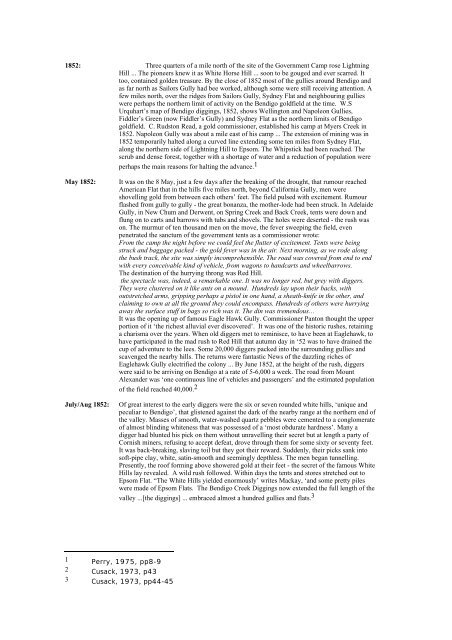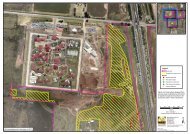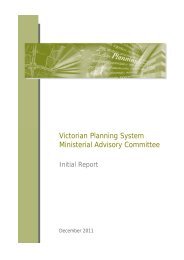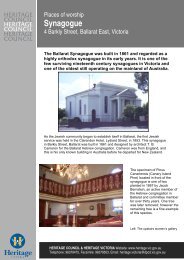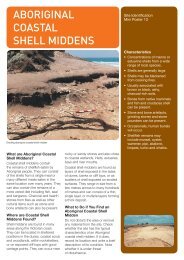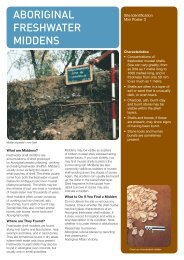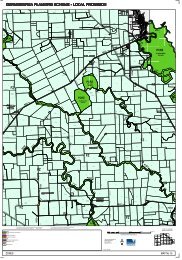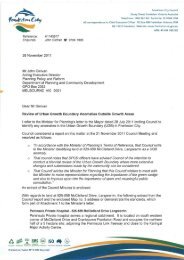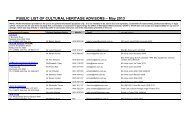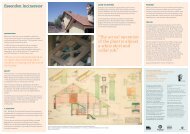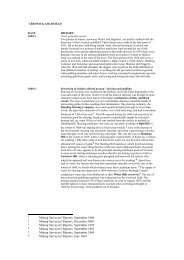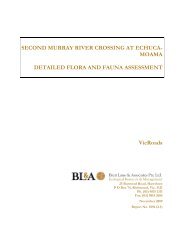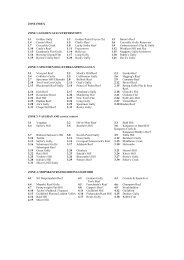Bendigo General History - Department of Planning and Community ...
Bendigo General History - Department of Planning and Community ...
Bendigo General History - Department of Planning and Community ...
Create successful ePaper yourself
Turn your PDF publications into a flip-book with our unique Google optimized e-Paper software.
1852: Three quarters <strong>of</strong> a mile north <strong>of</strong> the site <strong>of</strong> the Government Camp rose Lightning<br />
Hill ... The pioneers knew it as White Horse Hill ... soon to be gouged <strong>and</strong> ever scarred. It<br />
too, contained golden treasure. By the close <strong>of</strong> 1852 most <strong>of</strong> the gullies around <strong>Bendigo</strong> <strong>and</strong><br />
as far north as Sailors Gully had bee worked, although some were still receiving attention. A<br />
few miles north, over the ridges from Sailors Gully, Sydney Flat <strong>and</strong> neighbouring gullies<br />
were perhaps the northern limit <strong>of</strong> activity on the <strong>Bendigo</strong> goldfield at the time. W.S<br />
Urquhart’s map <strong>of</strong> <strong>Bendigo</strong> diggings, 1852, shows Wellington <strong>and</strong> Napoleon Gullies,<br />
Fiddler’s Green (now Fiddler’s Gully) <strong>and</strong> Sydney Flat as the northern limits <strong>of</strong> <strong>Bendigo</strong><br />
goldfield. C. Rudston Read, a gold commissioner, established his camp at Myers Creek in<br />
1852. Napoleon Gully was about a mile east <strong>of</strong> his camp ... The extension <strong>of</strong> mining was in<br />
1852 temporarily halted along a curved line extending some ten miles from Sydney Flat,<br />
along the northern side <strong>of</strong> Lightning Hill to Epsom. The Whipstick had been reached. The<br />
scrub <strong>and</strong> dense forest, together with a shortage <strong>of</strong> water <strong>and</strong> a reduction <strong>of</strong> population were<br />
perhaps the main reasons for halting the advance. 1<br />
May 1852: It was on the 8 May, just a few days after the breaking <strong>of</strong> the drought, that rumour reached<br />
American Flat that in the hills five miles north, beyond California Gully, men were<br />
shovelling gold from between each others’ feet. The field pulsed with excitement. Rumour<br />
flashed from gully to gully - the great bonanza, the mother-lode had been struck. In Adelaide<br />
Gully, in New Chum <strong>and</strong> Derwent, on Spring Creek <strong>and</strong> Back Creek, tents were down <strong>and</strong><br />
flung on to carts <strong>and</strong> barrows with tubs <strong>and</strong> shovels. The holes were deserted - the rush was<br />
on. The murmur <strong>of</strong> ten thous<strong>and</strong> men on the move, the fever sweeping the field, even<br />
penetrated the sanctum <strong>of</strong> the government tents as a commissioner wrote:<br />
From the camp the night before we could feel the flutter <strong>of</strong> excitement. Tents were being<br />
struck <strong>and</strong> baggage packed - the gold fever was in the air. Next morning, as we rode along<br />
the bush track, the site was simply incomprehensible. The road was covered from end to end<br />
with every conceivable kind <strong>of</strong> vehicle, from wagons to h<strong>and</strong>carts <strong>and</strong> wheelbarrows.<br />
The destination <strong>of</strong> the hurrying throng was Red Hill.<br />
the spectacle was, indeed, a remarkable one. It was no longer red, but grey with diggers.<br />
They were clustered on it like ants on a mound. Hundreds lay upon their backs, with<br />
outstretched arms, gripping perhaps a pistol in one h<strong>and</strong>, a sheath-knife in the other, <strong>and</strong><br />
claiming to own at all the ground they could encompass. Hundreds <strong>of</strong> others were hurrying<br />
away the surface stuff in bags so rich was it. The din was tremendous…<br />
It was the opening up <strong>of</strong> famous Eagle Hawk Gully. Commissioner Panton thought the upper<br />
portion <strong>of</strong> it ‘the richest alluvial ever discovered’. It was one <strong>of</strong> the historic rushes, retaining<br />
a charisma over the years. When old diggers met to reminisce, to have been at Eaglehawk, to<br />
have participated in the mad rush to Red Hill that autumn day in ‘52 was to have drained the<br />
cup <strong>of</strong> adventure to the lees. Some 20,000 diggers packed into the surrounding gullies <strong>and</strong><br />
scavenged the nearby hills. The returns were fantastic News <strong>of</strong> the dazzling riches <strong>of</strong><br />
Eaglehawk Gully electrified the colony ... By June 1852, at the height <strong>of</strong> the rush, diggers<br />
were said to be arriving on <strong>Bendigo</strong> at a rate <strong>of</strong> 5-6,000 a week. The road from Mount<br />
Alex<strong>and</strong>er was ‘one continuous line <strong>of</strong> vehicles <strong>and</strong> passengers’ <strong>and</strong> the estimated population<br />
<strong>of</strong> the field reached 40,000. 2<br />
July/Aug 1852: Of great interest to the early diggers were the six or seven rounded white hills, ‘unique <strong>and</strong><br />
peculiar to <strong>Bendigo</strong>’, that glistened against the dark <strong>of</strong> the nearby range at the northern end <strong>of</strong><br />
the valley. Masses <strong>of</strong> smooth, water-washed quartz pebbles were cemented to a conglomerate<br />
<strong>of</strong> almost blinding whiteness that was possessed <strong>of</strong> a ‘most obdurate hardness’. Many a<br />
digger had blunted his pick on them without unravelling their secret but at length a party <strong>of</strong><br />
Cornish miners, refusing to accept defeat, drove through them for some sixty or seventy feet.<br />
It was back-breaking, slaving toil but they got their reward. Suddenly, their picks sank into<br />
s<strong>of</strong>t-pipe clay, white, satin-smooth <strong>and</strong> seemingly depthless. The men began tunnelling.<br />
Presently, the ro<strong>of</strong> forming above showered gold at their feet - the secret <strong>of</strong> the famous White<br />
Hills lay revealed. A wild rush followed. Within days the tents <strong>and</strong> stores stretched out to<br />
Epsom Flat. “The White Hills yielded enormously’ writes Mackay, ‘<strong>and</strong> some pretty piles<br />
were made <strong>of</strong> Epsom Flats. The <strong>Bendigo</strong> Creek Diggings now extended the full length <strong>of</strong> the<br />
valley ...[the diggings] ... embraced almost a hundred gullies <strong>and</strong> flats. 3<br />
1 Perry, 1975, pp8-9<br />
2 Cusack, 1973, p43<br />
3 Cusack, 1973, pp44-45


